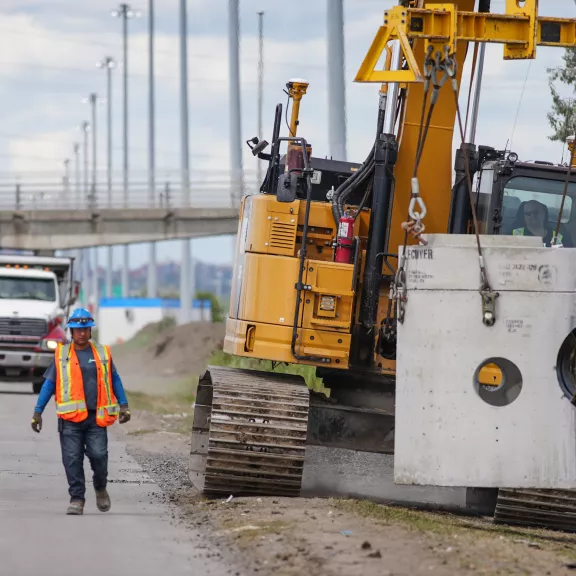
By Nahid Salem, Environment and Sustainability Coordinator
In 2020, Transport Quebec (MTQ) awarded the contract to conduct major repairs on the Louis-Hippolyte Lafontaine Tunnel to Renouveau La Fontaine (RLF), a consortium consisting of Pomerleau, Eurovia, and Dodin Campenon Bernard. Every day, nearly 120,000 vehicles, 13% of which are trucks, circulate through this busy artery inaugurated in 1967, making it the busiest freight transport crossing between the South Shore and Montreal. Maintaining and optimizing operation of this key infrastructure while ensuring user safety is thus crucial.
The project includes major structural works to repair the tunnel’s interior, the addition of rockfill on the floor of the St. Lawrence River to protect the tunnel’s infrastructure, the reconstruction of 35 km of concrete pavement on Highway 25, and the addition of a third lane to Highway 20 reserved for buses.
Carbon neutrality: a key goal
The environmental impacts of a project of this scale are numerous, most notably its carbon footprint. To reduce these impacts, the construction activities being conducted on site are seeking to achieve carbon neutrality.
Direct and indirect emissions will be included in the project’s carbon footprint. Direct sources of emissions include energy consumed by on-site trailers, fuel used by on-site machinery, fixed and mobile equipment, as well as emissions produced by RFL’s vehicles. Elsewhere, emissions related to the transportation of construction materials to the site, of employee and subcontractor transportation between the various sectors of the site, transport of waste, residual and excavated materials will also be included. Auditing of the carbon assessment will be conducted by an accredited external third party in accordance with ISO 14064-3, an internationally recognized standard used to provide guidance for the validation and verification of GHG emissions.
According to current data, 2,051 tonnes of CO2-eq were emitted from January to July 2021. To put these numbers in context, these emissions equate to 8,303,563 km driven by a single medium-sized vehicle or 249,732,353 smart phone charges. Conversely, 2,513 acres of forest are required to offset this amount of carbon for a year.
As the data shows, achieving carbon neutrality will be a challenge. RLF has implemented several GHG reduction initiatives to help achieve this goal. These include the use of hybrid (60%) and electric (40%) vehicles and installing on-site charging stations, targeting 80% recovery of residual materials, minimizing reduction of site deforestation, implementation of an engine shutdown policy and offering eco-driving training to employees. The project will also implement an ISO 14001 certified environmental management system and will implement several measures to protect the surrounding flora and fauna.
Carbon offset solutions related to the project have not been selected. Once the construction activities completed, potential tree planting solutions and the purchase of carbon credits will be evaluated. RFL has committed to consulting the MTQ regarding offsetting opportunities, with priority given to initiatives located within Québec and which fall within the Western Climate Initiative, the organization that coordinates emissions trading between Quebec, Nova Scotia, and California.
The carbon footprint accounting effort tied to this project aligns closely with Pomerleau's strategic priority of taking a leading role in the fight against climate change. While the LHL Tunnel is one of the first in Pomerleau's portfolio of projects to target carbon neutrality, it will certainly not be the last!